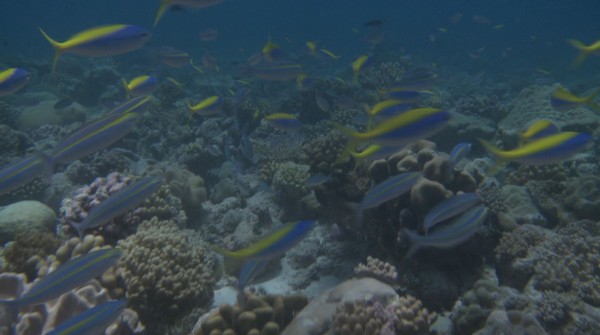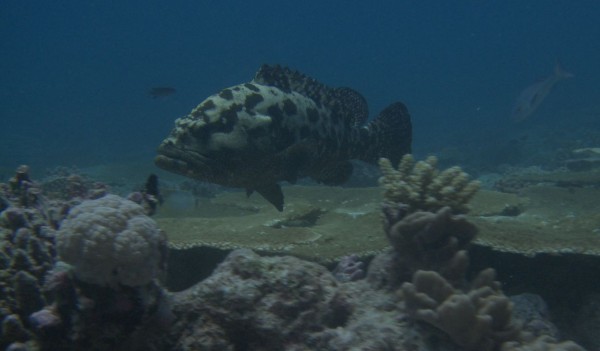Febuary 2013 Expedition - Grouper, triggerfish, morey eels, fusiliers, jacks, snappers…
On these science expeditions to Chagos, we return to sites previously visited, to track changes and accurately measure and compare information gathered there before. Even these prescribed dives (and even those onto the oceanside slopes of reefs that are most exposed to the prevailing weather), are breathtakingly beautiful. They are also heaving with fish life. And the fish swim in and over endless sproutings and coatings of soft and hard corals of various hues.
Some of the best science sites are quite remarkable. Beyond 100% coral cover as numerous species grow around, over and beneath each other, in an impossibly complex jigsaw of life that leaves no gaps for the substrate to peak through. Elsewhere, your destination will offer up a number of sites to providing you with the best submerged vistas on offer.

Photo: Fusiliers swim over hard and soft corals (c) Jon Slayer
Often, in other locations around the world, there are usually a few dives that are top class and the remainder trail off to average. Or in the most degraded of coral reefs, to little more than piles of rubble with the occasional outbreak of algae sporadically guarded by a skittish remnant of flighty little fish.
So returning to Chagos is always an absolute pleasure.
However, my favourite times in the water are undoubtedly when - for various reasons - I gain some independence over where I can dive. I drive the boat to a point, pick a spot at random, and drop over the side.
This was what I did this morning, after an early start with terrestrial work on Ile Vache Marine.
Close to midday we found the time to head out in our boat and plunge from the heat of the day into the cool waters off the south eastern edge of the Isle.
I was immediately captivated by the stunning spread of coral and fish sloping gently before me. Soon, I lost my dive buddy as he swam in a completely different direction, entranced by a black tip shark. Duly reconnected after a few expletives, and following the dive protocol, we dropped back down straight onto a field of tabletop acropora corals that would better be described as garden decks. Some of them stretched their spreading branches over a five meter diameter.

Photo: A large grouper eyeing out the camera over an acropora table (c) Jon Slayer
Whilst filming a multi-layered version of these spectacular corals, I froze as a nurse shark appeared sinuously, gliding over the contours of the coral heads. Unstartled by my stony immobility, he turned in the corner of my camera frame, and swam gracefully straight over the coral head I was filming. Then exited stage left.
Grouper, triggerfish, morey eels, fusiliers, shoals of jacks and snappers, countless damsels and a plethora of gnawing multicoloured parrotfish later, we ran short of air and reluctantly returned to the surface.
You don’t need to choose an amazing dive site in the Chagos – you just have to select a spot and get underwater.
Jon Slayer

